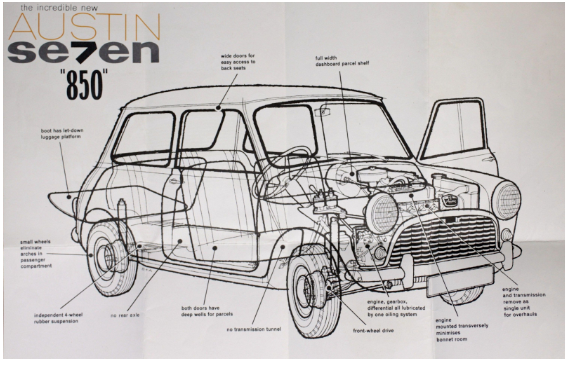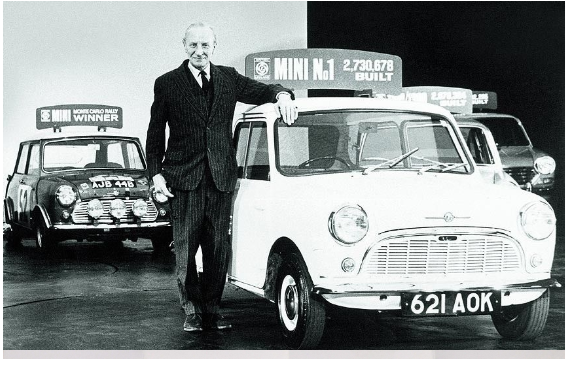The Classic Mini was designed by visionary engineer Alec Issigonis and launched by the British Motor Corporation (BMC) in 1959.
This guide delves into the origins and innovative design of the Classic Mini, explores the circumstances that led to its creation, and traces how its design has evolved over the decades.
Whether you're a classic car enthusiast or simply curious about automotive history, this guide provides an in-depth look at the legacy of the beloved Mini, and the man that designed it.
Who Designed the Classic Mini?
The Classic Mini was launched by the British Motor Corporation (BMC) after being designed by Englishman Alec Issigonis in 1959. Issigonis was born in 1906 in Smyrna (now Izmir, Turkey) and moved to England at the age of six.
After studying engineering at University, Alec Issigonis would work at Morris Motors, later renamed the BMC, where his innovative thinking eventually led to the creation of the first Mini. Initially introduced as the 'Austin Seven' and variant the ‘Morris Mini Minor’, the car quickly became known as the Austin Mini.
Issigonis's design was revolutionary, featuring a transversely mounted engine with the gearbox placed underneath and a front wheel drive, which allowed 80% of the floorpan to be used for passengers and luggage. This compact yet spacious design maximised interior space and efficiency, making the Mini an icon of economical and practical motoring during the postwar era.
Issigonis would go on to become a fellow of the Royal Society in 1967 and was even knighted in 1969. The Mini’s influence was so profound that it was voted the second most influential car of the 20th century in 1999, cementing Issigonis's legacy in automotive history.

Classic Mini Austin Seven Design via CarExpert
Where Did the Idea For the Classic Mini Come From?
The idea for the Classic Mini design was sparked by the oil crisis that arose from the Suez Crisis in 1956. During the Second World War, Britain had control over the Suez Canal, a vital route for oil supplies. However, this changed when political turmoil led to the loss of British sovereignty over the canal, resulting in a significant oil shortage.
This crisis created a pressing need for more fuel-efficient vehicles, presenting Alec Issigonis with an opportunity to demonstrate his engineering prowess. He was tasked by BMC management to develop a small car that could be produced quickly to address the urgent demand for a more economical vehicle.
Issigonis needed to create a car that maximised interior space while minimising exterior dimensions, accommodated four passengers, offered excellent driving characteristics, superior fuel economy, and had an affordable price.

Image: Sir Alec Issigonis with the first Mini. The Telegraph
Rising to the challenge, Issigonis devised an innovative design featuring a transverse engine layout, which allowed for a more compact structure without sacrificing interior space. This clever design not only addressed the immediate need for an economical car, but also set a new standard in automotive engineering for small cars.
The resulting Classic Mini was more than just a practical solution to an oil crisis. It became an icon of efficient design and a precursor to many modern small car layouts.
How Has the Mini Design Changed Since 1959?
- 1959: Launch of the original Mini as the Morris Mini Minor and Austin Seven (later Austin Mini). Known for its compact design with a transverse engine layout.
- 1961: Introduction of the Morris Mini Cooper and Austin Mini Cooper, a sportier version of the original design developed by John Cooper. It featured a more powerful engine and upgraded brakes.
- 1967: Release of the Mini Mk II, featuring a redesigned front grille, larger rear window, and improved mechanical components. 429,000 Mk II Minis were produced.
- 1969: Introduction of the Mini Clubman with a squarer front design, developed due to a want to expand the Mini concept without spending too much money.
- 1980: Launch of the Mini Metro, a larger and more modern variant, though the classic Mini continued production.
- 1990: Introduction of the Rover Mini Cooper, marking the return of the classic Mini Cooper name after 19 years, with modern updates.
- 2000: End of production for the classic Mini after over 40 years.
- 2001: Introduction of the new Mini under BMW ownership, featuring modern design elements while retaining classic Mini styling cues.
- 2014: Launch of the third-generation modern Mini, featuring updated technology, improved safety, and various body styles including hatchback, convertible, and crossover.
The Classic Mini: A Design That Never Gets Old
The Classic Mini’s design is instantly recognizable by its compact size, friendly round headlights, and distinctive front grille. The car's simplicity and charm make it a favourite among collectors who appreciate a retro style. The minimalistic yet functional dashboard, cosy interior, and variety of vibrant colour options further enhance its nostalgic appeal.
Beyond its looks, the Classic Mini’s design offers numerous practical benefits that make it a joy to restore and drive. Its small footprint allows for easy manoeuvrability in tight spaces, making it ideal for both city driving and open roads.
On top of this, the transverse engine layout and front-wheel drive not only maximise interior space but also provide excellent handling and stability. These features make the Mini a practical choice for daily use even decades after its original production.
Where To Buy Classic Mini Parts
Restoring this best-selling British car can be a highly rewarding experience. The simplicity of its mechanical design, originally created by English engineer Alec Issigonis, makes it accessible for both seasoned and novice restorers.
Due to its popularity, there is a wealth of resources available, including original parts, replica components, and detailed restoration guides. Additionally, the community of Mini enthusiasts is vibrant and supportive, offering a wealth of knowledge and
MGOC Spares stock a huge range of parts and accessories for your Classic Mini! Browse through our section below to find your next essential part.
Shop Classic Mini Parts & Spares today